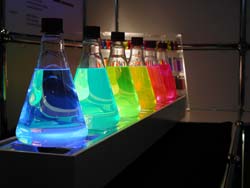ATTO-TEC® Stable activated fluorescent dyes at room temperature (RT)

ATTO-TEC® has developed the second generation of fluorescent dyes which are stable at room temperature for more than six months.
With Atto 520, Atto 565 and Atto 590 we are pleased to offer three stable fluorescent dyes as amine-reactive succinimidyl esters which will be available from November 2001 on. This allows researchers an easy handling for selectively target- labeling by linking a fluorophore to primary amine groups on proteins or modified nucleic acids.
Further stable activated fluorescent probes including Atto 610, Atto 655 and Atto 680 will be also available shortly.
ATTO-TEC® Stabile aktivierte fluoreszierende Farbstoffe bei Raumtemperatur
ATTO-TEC® hat die zweite Generation fluoreszierender Farbstoffe entwickelt. Die neuen Farbstoffe sind selbst bei Raumtemperatur für mehr als sechs Monate stabil.
Mit Atto 520, Atto 565 und Atto 590 bietet ATTO-TEC® erstmalig drei bei RT stabile Farbstoffe als aktivierte NHS-Ester an. Die Produkte sind ab November 2001 verfügbar. Dies ermöglicht den Anwendern die einfache Handhabung der Fluorophore bei der Markierung der gewünschten Zielmoleküle durch selektive Bindung des Farbstoffes an Aminogruppen von Proteinen und modifizierten Nukleinsäuren.
Weitere bei RT stabile aktivierte fluoreszierende Farbstoffe, insbesondere Atto 610, Atto 655 und Atto 680, werden in Kürze ebenfalls erhältlich sein.
Media Contact
All latest news from the category: Life Sciences and Chemistry
Articles and reports from the Life Sciences and chemistry area deal with applied and basic research into modern biology, chemistry and human medicine.
Valuable information can be found on a range of life sciences fields including bacteriology, biochemistry, bionics, bioinformatics, biophysics, biotechnology, genetics, geobotany, human biology, marine biology, microbiology, molecular biology, cellular biology, zoology, bioinorganic chemistry, microchemistry and environmental chemistry.
Newest articles

“Nanostitches” enable lighter and tougher composite materials
In research that may lead to next-generation airplanes and spacecraft, MIT engineers used carbon nanotubes to prevent cracking in multilayered composites. To save on fuel and reduce aircraft emissions, engineers…

Trash to treasure
Researchers turn metal waste into catalyst for hydrogen. Scientists have found a way to transform metal waste into a highly efficient catalyst to make hydrogen from water, a discovery that…

Real-time detection of infectious disease viruses
… by searching for molecular fingerprinting. A research team consisting of Professor Kyoung-Duck Park and Taeyoung Moon and Huitae Joo, PhD candidates, from the Department of Physics at Pohang University…





















